 By Michele Bogle By Michele Bogle
August 5th, 2020
BURLINGTON, ON
The ‘in-tent’ of this article is to shed light on a new cost of doing business in Burlington.
Stage 3 has provided restaurateurs the ability to bring patrons inside but several of the owners I talked to said they didn’t feel the public was ready for that step.
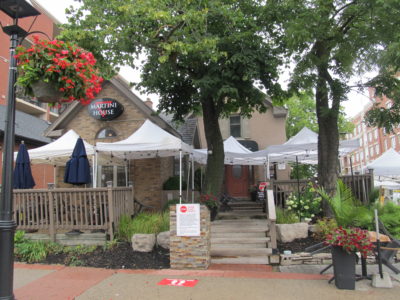 The Martini House had a limited amount of space and managed to make it work. Candlelight at night didn’t hurt. You may have noticed an increasing number of tents popping up around the city for the past month; I toured the tents at Jake’s Grill & Oyster House, Stacked, The Martini House, The Poacher and Jack Astor’s.
The question for the owners of these restaurants isn’t, “How can they not, but rather, can owners actually afford to?”
For those with space, some restaurants have included a tent to an expanded patio setup. For others like The Martini House, space is at a premium so they got creative with the size and number of tents.
Some have spent hundreds of dollars adorning the tents in an effort to mirror that same ‘dining-in’ experience.
Customers are enjoying the tents for larger groups: “We feel like we’re all together this way than at separate patio tables.” Another mentioned that, “With the lights on under the tent, it’s more romantic.”
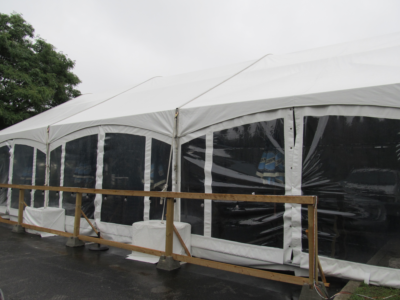 Jake’s Grill & Oyster House went for the high end tent. While the Alcohol and Gaming Commission of Ontario waived fees for licensing under the tents until January 1, 2021 as long as they are COVID-19 safety compliant, the average sized 15’ x 30’ tent rentals start at $500 per day.
Some, who don’t require special customizations, have bought and others have borrowed.
Most owners still offer curbside service and delivery with apps like SkipTheDishes, Uber Eats and DoorDash, but the apps charge, on average, thirty percent per order.
In an attempt to give relief to restaurants during the onset of COVID-19, Uber Eats and DoorDash waived the delivery fee, but only until May. Now the popular apps run assorted promotions like DoorDash who ‘waived delivery fee’ on the first order over $15.
The Poacher’s owner, who has a huge space that will seat 70, admits that the use of the tents makes business barely sustainable in the short term. For obvious reasons, rainy weather like we’ve had for consecutive days now, has a significant impact on business. Owners are looking to October as the magic month of cooler weather that will bring customers back inside the premises.
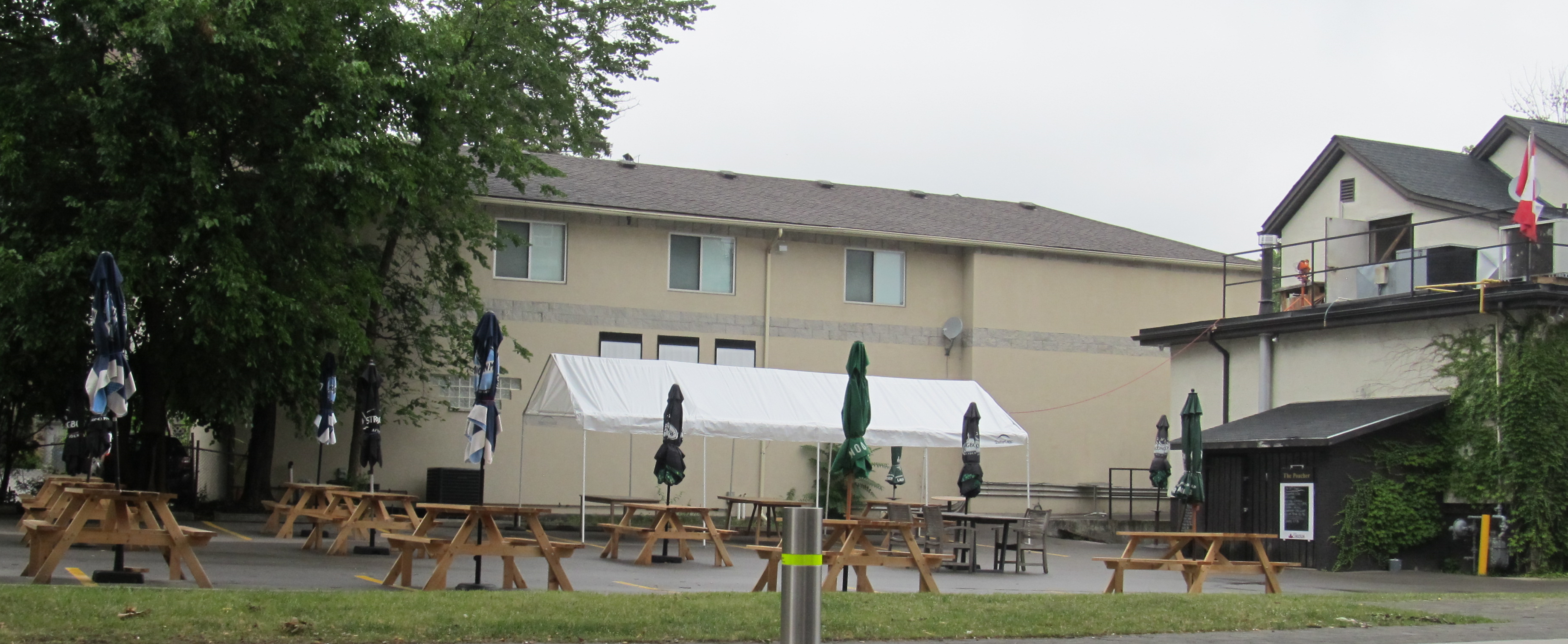 For those who have the space – a reasonably large outdoor operation can be set up. The Poacher has space for 70 people. As a sign of loyalty to the customers many of the restaurants haven’t raised their prices.
In an effort to keep the lights on inside of your favourite eateries, will you consider ‘dining-out’? This sector needs the help and being able to get out for a meal with friends is something that will cheer you up as well.
Michele Bogle is a Burlington based free lance writer with a focus on the hospitality and entertainment sectors.

 By Pepper Parr By Pepper Parr
August 4th, 2020
BURLINGTON, ON
We did a photo feature earlier today with photographs showing people out and about the city not wearing masks.
A number of people thought we were wrong and told us so via their Facebook comments.
The public health objective is to reduce the rate at which infections get passed from person to person.
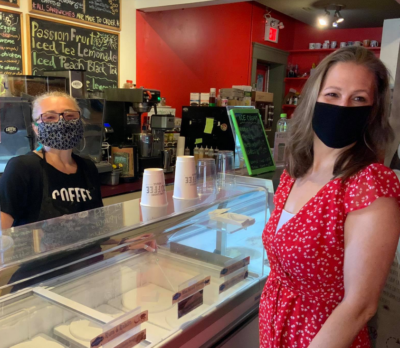 Mayor of the city wears a mask Wearing a face mask was made mandatory by the city in July. The bylaw was very specific – requiring people in offices and retail locations to wear a face mask.
Many think that the wearing of a mask outdoors is not necessary. Is it just a matter of personal choice or does it mean looking at the options and deciding how careful you want to be ?
The risk is certainly lower outdoors – but it is still a risk – when you add the results of geometric progression to that risk you can see why masks work.
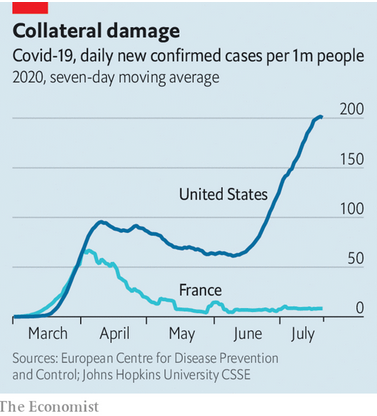 Haven’t heard of geometric progression? The explanation for the pattern of American infections lies in something of central importance to the spread of a virus: geometric progression, such as 1, 2, 4, 8, 16. Haven’t heard of geometric progression? The explanation for the pattern of American infections lies in something of central importance to the spread of a virus: geometric progression, such as 1, 2, 4, 8, 16.
If one person infects two, two infect four and so on. Unless the rate of infection is driven down by reducing contacts, any geometric increase quickly balloons: 256, 512, 1,024.
The graph makes it clear that when lock downs were in place rates of infection dropped. When the Americans opened things up, in early June – and didn’t require masks – the rate of infections soared.
Simple math… 2048, 4096, 8192, 16,384 – do you want to keep going?

 By Pepper Parr By Pepper Parr
August 4th, 2020
BURLINGTON, ON
It wasn’t the greatest long weekend was it?
The Saturday sunshine worked for a lot of people – some of the rules didn’t work all that well.
The city passed a temporary bylaw requiring requiring people to wear face masks.
Our roving photographer wandered around the city looking in on the traditional hot spots – the Beach, the Pier and the downtown area. It was hard to find anyone wearing a mask.
Do people not know – or they just don’t give a damn.
A picture being 1000 words – here is a long story.
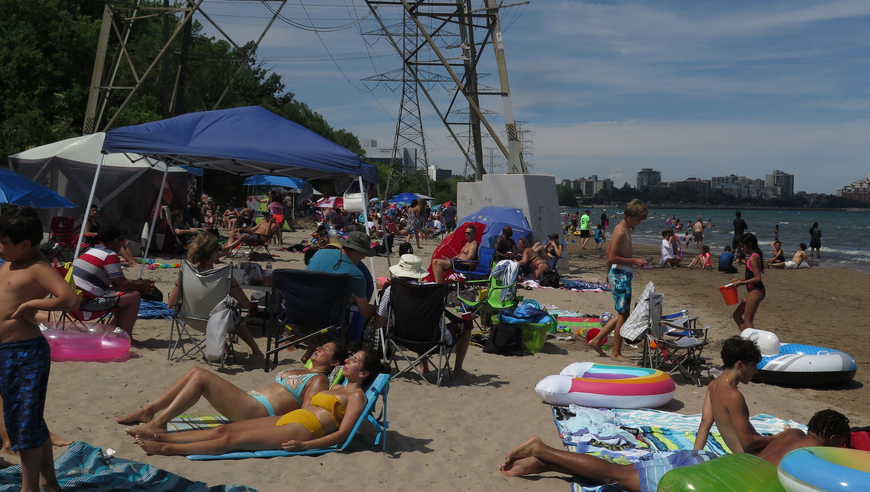 The Beach was packed – no masks but it didn’t seem to matter and it would get in the way of acquiring that tan. 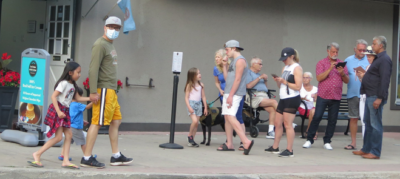 People outside a local shop. Not many masks being worn here. Beer Store on the right – line up respecting the six foot thing – but no masks. 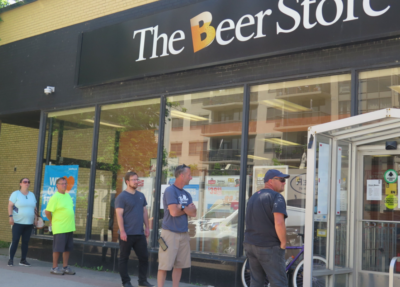
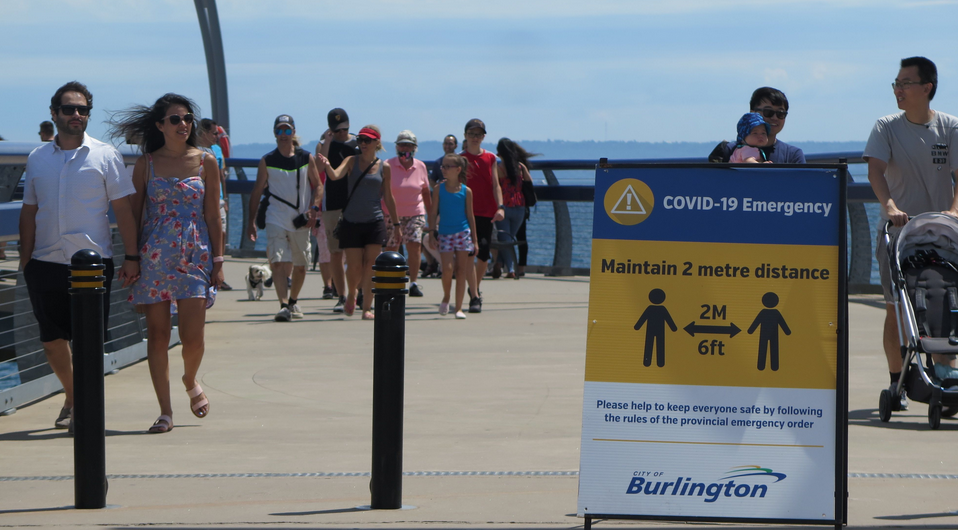 Maybe the summer breeze made it unnecessary to wear a face mask 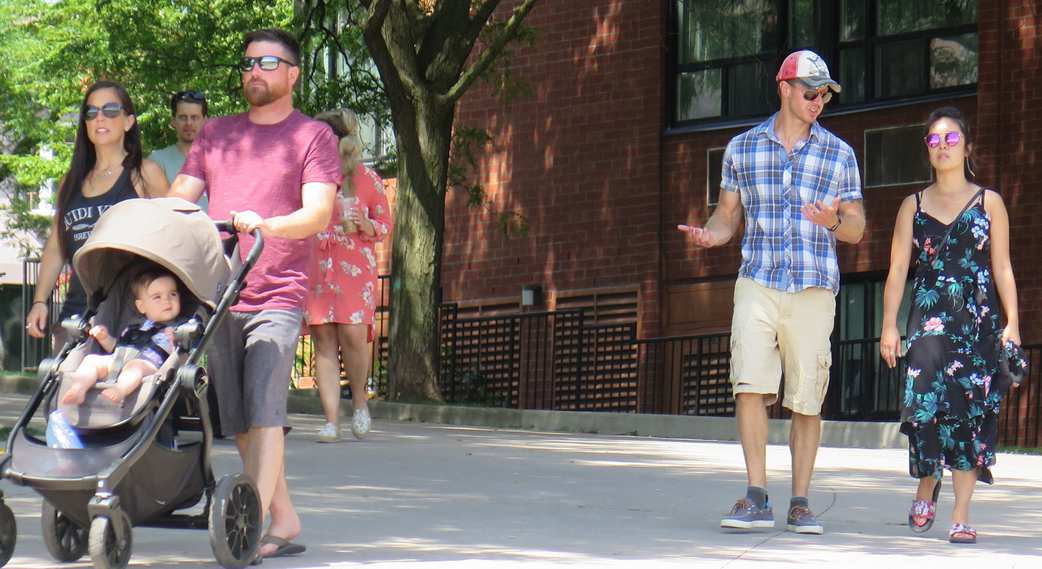 On the way into Spender Smith Park. Great weather – no masks. 
 By Pepper Parr By Pepper Parr
August 4th, 2020
BURLINGTON, ON
We’ve all worked and sacrificed a lot to get us to this new normal.
Businesses are opening up across the Region and life is resuming some sense of normality, including riders coming back to public transit.
There is a dotted line that connects life when we are not using public transit to keeping others safe when you do use public transit.
 Metrolinx senior manager of media, Anne Marie Aikins Metrolinx senior manager of media, Anne Marie Aikins – who has been acting as the Emergency Information Officer for Metrolinx during the COVID-19 pandemic – connects those dotted lines.
“ At this point in time it is so easy to let our guard down.
“To give in – for a bit – and try not to let the ongoing pandemic rob of us of any more intimate moments of close contact with those we’ve done without.
“But this war on COVID-19 is not over – not by a long shot. It is easy to forget the enemy and leave a door open.
“Our actions in the back yard, or on a restaurant patio, or greeting friends in a park on a bright summer day, carry over into every other part of our days – and the many people we come in contact with or even pass on a GO Transit train or bus.”
Metrolinx began 2020 by initiating their pandemic response plan. It has been over six months since the first person in Canada tested positive for the Coronavirus. And now more than 116,000 people have tested positive and, tragically, nearly 9,000 have died from this virus.
For more than 130 days, at times excruciatingly lonely days, people have faithfully followed the guidance of our public health officials.
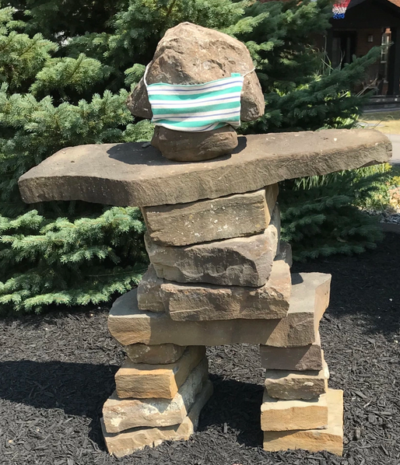 Masks for everyone – everywhere. “That’s a long time to go without any hugs or handshakes, parties or celebrations, sustained visits or contact with our colleagues, family and friends who nurture, entertain, commiserate and support us throughout our life during the best of times but most especially during the worst of times” said Aikins, who adds: We’ve all been starved of contact and connection.
“We’ve missed all the usual weddings, graduations, vacations and funerals. No video conference call can ever replace the healing power of a single warm embrace.
“No doubt, life has been hard — especially for those on the front lines. Many people have really suffered, lost loved ones to this virus, lost income due to job loss or lost a stable home or relationship. Our collective mental health has taken a beating and many are feeling wounded.
“We’re exhausted by it all and desire some sense of security and peace that only our friends and family can provide.
“I get that. I’m an extrovert that thrives around smart, creative, funny, passionate people – but there is so much to lose if we let our exhaustion give into the desire to throw the health rules under, well, the bus.”
Public health officials have seen some worrisome trends of late — although we’ve continued to make progress on reducing the transmission, the numbers of people contracting the virus still persists and younger people now account for half the growth of cases perhaps related to house parties or other big gatherings.
Convincing our youth to use protection has always been a challenge we’ve often failed at miserably. Risky behaviours, however are not reserved to only the frisky.
COVID is not taking the summer off, so we all, young and not so young, must not let down our guard.
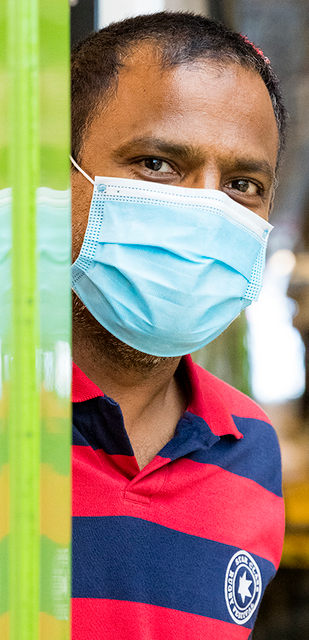 Go Transit customer S. Thiru, aboard a GO train. (Lorne Bridgman photo) As ridership increases and physical distancing becomes more of a challenge on our services, face coverings are critical in making people feel safer on their journey and limit the transmission of the virus. Metrolinx has made face masks mandatory. Their customers responded as the good partners they are and most have been wearing their face coverings or non-medical masks faithfully.
There are other equally necessary measures. Continue to stay home if you are sick or think you’ve been exposed. Get tested. It’s easy, just a wee bit uncomfortable in the nose region, and testing is readily available and quick.
Aikins adds: “I hate to burst your bubble, but please choose how many you let into your circle judiciously. You don’t want that moment of glory, of reconnecting with friends, to become regretted and a cautionary tale for others.
“Keep everyone outside your circle at a distance, six feet away specifically whenever possible.
“Wash your hands frequently. Scrub them like you just picked up your pooch’s poo. That works for me better than the birthday song. Use hand sanitizer too — you can find it everywhere now. Keep some in your purse or jacket and throw in some disinfecting wipes. It’s often as easy as toilet paper to find in stores now.
“As you open up your social bubbles, keep your visiting outdoors. Enjoy the nice weather. It’s good for the soul. And the fresh air reduces the virus’ ability to spread.
“As horrific as the tally of illness and deaths has been, the losses could have been so much higher if not for your commitment to protecting public health throughout this pandemic.
“You saved lives.
“Now is the time to double down in your resolve. The celebrations, the public good-byes and the healing will come in time.”
This article draws liberally from a piece written by Anne Marie Aikins, Metrolinx senior manager, Media.

 By Pepper Parr By Pepper Parr
August 4th, 2020
BURLINGTON, ON
He may not have a seat in the Legislature but Steven Del Duca, Leader of the Ontario Liberal Party, is playing political hardball and using the returning students to school issue as the baseball bat with which he is battering the Premier.
Last week he put forward a plan to get the schools opened opened in September that put student safety at the top of the list.
This week he is calling what the province announced on Thursday as the Premier’s “half-baked plan to reopen schools” which Del Duca claims “is nothing short of a catastrophe for parents, students, and teachers. The plan falls short of even the basic standards set out by Sick Kids and blatantly ignores recommendations from school boards, teachers, education workers, healthcare associations, and parents.
“Parents in Halton have been waiting anxiously for a plan to reopen schools safely – Doug Ford gave them one written on the back of a napkin,” said Del Duca. “None of the concerns parents raised have been addressed. None.”
Doug Ford’s school reopening plan gets a failing grade on every measure. The SickKids’ report, released last week, makes it clear that a proper plan must include smaller class sizes and a significant amount of new caretakers (custodians and cleaning staff).
“The Ontario Liberal Party took this advice seriously and, in consultation with experts in health care and education, released their Plan to Help Our Students last week.
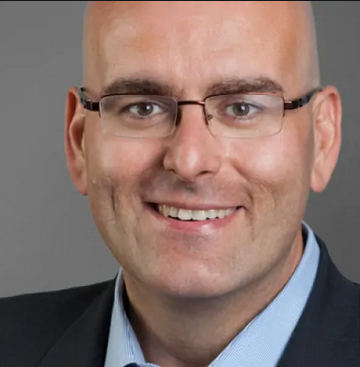 Steven Del Duca, Leader of the Liberal Party in Ontario “To reopen safely, the Liberal plan would fund 650 new classrooms in Halton, which are necessary to allow for physical distancing. Under Doug Ford’s Conservatives, there will be no new spaces at all.
“The Liberal plan would also support 710 new teaching positions in Halton to help keep class sizes small. Doug Ford’s plan only supports 14.
“To keep classes and schools clean, the Liberal plan would also create 320 new caretaker positions in Halton. The Conservatives will only create 36. That’s about 1 for every 3 schools.
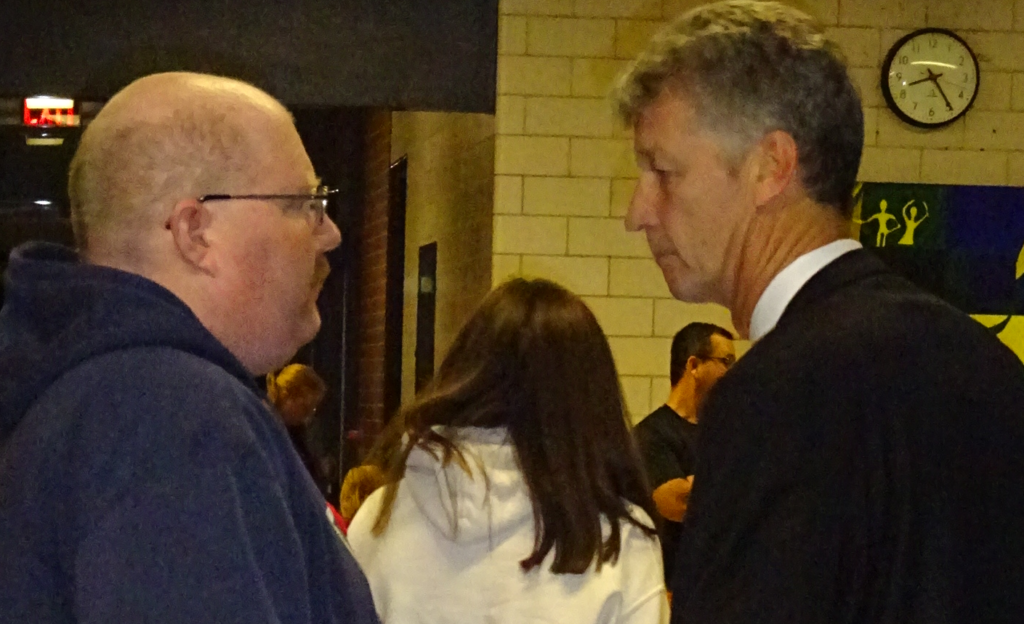 Director of Education Stuart Miller facing an irate parents during the Central School closing issue. Central prevailed and is still open. Del Duca adds that: “This plan continues to make it clear that Doug Ford is treating our students, their parents and everyone involved in the public education system as an afterthought. What Doug Ford gave us isn’t a plan to safely reopen schools – what he gave us was irresponsible. It doesn’t provide the smaller class sizes we need or enough resources to keep schools clean. It’s a dangerous roll of the dice with our kids’ safety.”
What Del Duca doesn’t include in his plan is where is anyone going to find the 650 classrooms that he maintains are needed. The space just doesn’t exist. As for the number of teachers – the Halton Board does not as yet know how many of the existing teachers are going to opt to return to a classroom.
Halton District School Board Director of Education Stuart Miller is surveying the teacher compliment to determine how many are not prepared to go into classrooms. Miller has said that he believes there are enough supply teachers who will teach in classrooms.

 By Staff By Staff
August 3, 2020
BURLINGTON, ON
The Halton Public Health Unit has created a “dashboard” that gives you an instant look on what has taken place in terms of COVID19 infections.
You can access the dashboard board HERE.
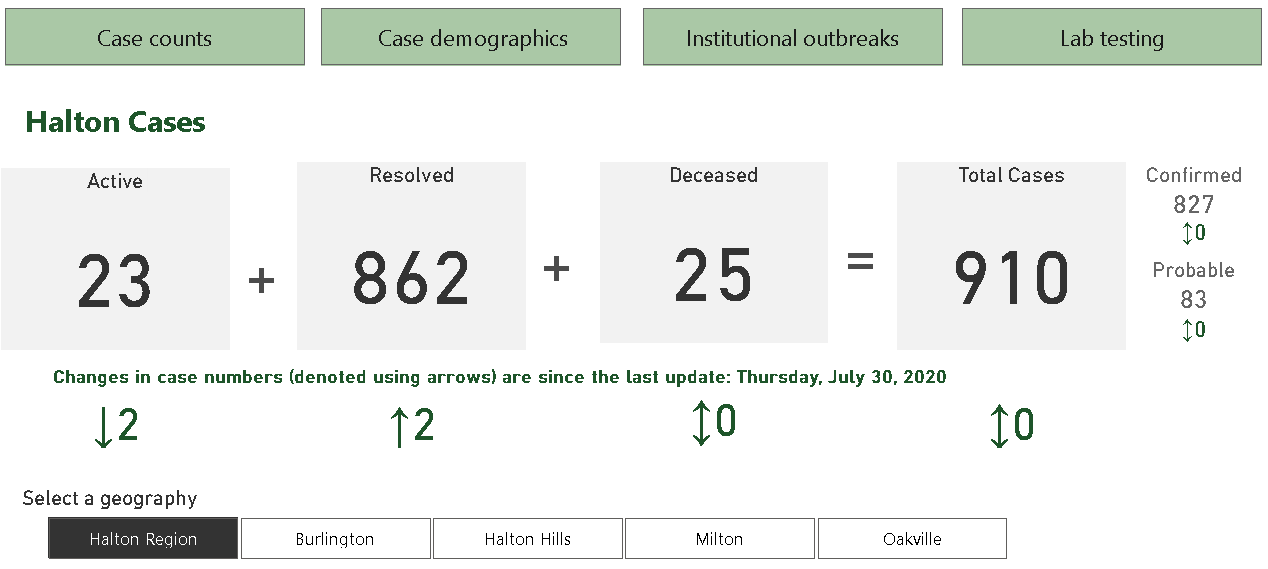 For a quick look at the COVID19 numbers for the Region – you can drill down to your community – the dashboard is a useful information source. Halton’s new interactive COVID-19 dashboard provides a summary of the current local situation and incorporates core epidemiological indicators of COVID-19 activity in Halton to date. Dashboard users can explore Halton’s COVID-19 data on overall case counts, case demographics, institutional outbreaks and lab testing.
As of July 17, Halton Region Public Health is currently in the process of adopting a new provincial COVID-19 database. During this transitional period, all counts should be considered preliminary and are subject to change as information is reconciled.

 By Pepper Parr By Pepper Parr
August 3rd, 2020
BURLINGTON, ON
A report published in the Washington Post (certainly a reputable news source) told of a summer camp in the State of Georgia where:
“Some 260 campers and staff tested positive out of 344 test results available.
“Among those ages 6-10, 51 percent got the virus; from 11-17 years old, 44 percent, and 18-21 years old, 33 percent. The campers did a lot of singing and shouting; did not wear face masks; windows were not opened for ventilation, although other precautions were taken.
The Centers for Disease Control and Prevention concluded that the virus “spread efficiently in a youth-centric overnight setting, resulting in high attack rates among persons in all age groups,” many showing no symptoms.”
It is happening and it is something that needs to be heeded.
Later this month the Halton District School Board will have something to say to the parents who send their children to the 105 schools in the Region.
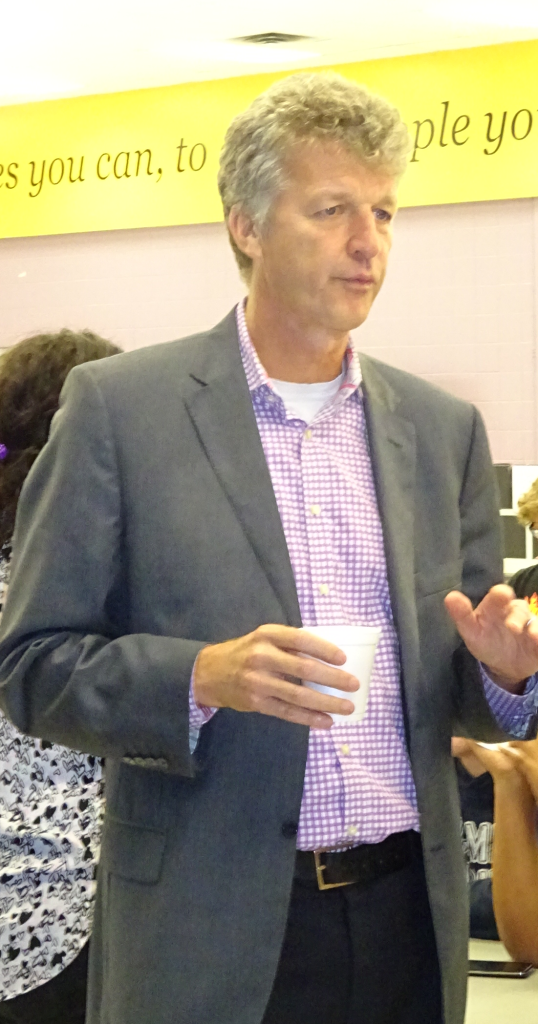 Halton District School Board Director of Education Stuart Miller. Facing the biggest challenge ever as an educator. All elementary students will attend classes five days a week. The students will stay in the classroom; teachers will move from classroom to classroom.
The students in each class will stay as a group during recess and lunch. It is not clear yet if teachers will be required to wear PPE.
Grades 4 to 12 will be required to wear masks in the classroom
Also not clear yet is how the school bus service will operate.
The province set out the rules: Elementary students in class five days a week; secondary students will be in classes half of each day. The second half will be done at home and on line.
The Gazette asked the Director of Education for a comment on the provincial decision and told us that they did not yet have the technical requirements from the province. That technical data was public on Friday.
The school board administration will be sending a survey to parents to learn what each family plans to do now that the rules from the province are clear.
There will be a lot of questions from the parents.
Senior school board staff worked hard to put together data for their presentation to Ministry of Education officials on Tuesday of last week where they had to explain how they would handle the three scenarios the province defined:
Full time classes – both elementary and secondary
All teaching done remotely
An Alternative approach that is a combination of the other two scenarios.
Many people were surprised when the province opted for opening up the existing classrooms for elementary students – some of those classes have 30 students.
These are trying days for parents, for the school board administrators who have to manage what is going to be a major challenge and for trustees who are not prepared for the onslaught of public complaints that will directed to them.
It is a situation that has to be closely monitored.
- Students in grade 4-12 will be required to wear masks with exceptions for things like eating.
- Mask exemptions will be accommodated for those with valid reasons such as respiratory challenges.
- For students in JK-Grade 3, masks will be optional but encouraged.
- Schools will implement additional hand hygiene, cohorting, and distancing.
- Visitors in schools will be limited and will require pre-registration.
- Masks will be provided to teachers and staff.
- If a student or staff member is experiencing any symptoms of the COVID-19, they will be required to stay home.
- Physical distancing will be implemented as much as possible.
- Parents are allowed to decide whether their child returns to school in-person this September.
- Students will have the option of remote learning, which would be delivered by the school board.
- Any student or staff member who develops COVID-19 symptoms will be immediately separated from others. Staff and parents will then be contacted by their health provider and be informed about COVID-19 testing centres.
- School staff will receive training on processes and procedures.
- Organized sports and clubs can proceed if physical distancing can be maintained and equipment is cleaned regularly.
- $309 million in new funding will help assist the safe reopening of schools.
- The government has allocated $60 million for masks and personal protective equipment, $80 million for funding for additional staff, $25 million on cleaning supplies and $10 million for health and safety training.
- $50 million has been allocated to hire up to 500 additional school-focused nurses in public health units to provide rapid-response support to schools and boards in facilitating public health and preventative measures, including screening, testing, tracing and mitigation strategies.
Related news stories:
School board chair speaks out.
Jim Young asks a lot of questions

 By Pepper Parr By Pepper Parr
August 3rd, 2020
BURLINGTON, ON
We are on the last day of a long weekend that has given us more rain than we expected.
People able to get out on the Saturday but come the evening the rains came and kept us wet for much of Sunday.
Last Friday we saw the updates of COVID-19 infection data from the Regional Medical Officer of Health. The numbers were acceptable. Now that we are in Stage 3 where people can move about much more – go into restaurants and gather in larger groups, we are about to be tested on just how disciplined we are going to be able to be.
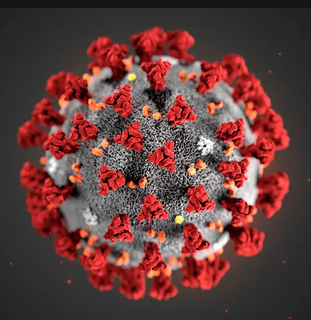 A graphic depiction of the virus. The virus is in the community – do we maintain individual personal discipline and wear face masks while outside, wash our hands frequently and maintain that six foot thing when we are amongst people we don’t know?
For a feature that explain just how this virus infect us CLICK HERE.
How well we do will show up in the Public Health numbers in a week to ten days. So we wait.
The Public Health numbers as of the 29th of July are set out below.
In Halton, made up of Burlington, Oakville, Milton and Halton Hills the total number of COVID-19 cases amount to 910, – 827 confirmed + 83 probable.
24 cases currently active among Halton residents – 22 confirmed + 2 probable.
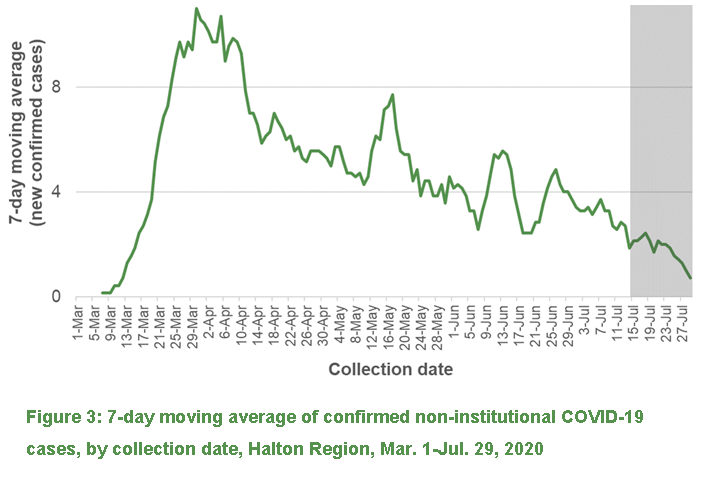
All cases have been graphed according to their episode date, which is used to estimate the date that symptoms began. Counts for the past 14 days should be interpreted with caution (indicated using the grey shaded area on the graph), since there is a delay between when a person becomes infected and when they develop symptoms, get tested and are reported as a case.
Probable cases are individuals presumed to have COVID-19 because they have symptoms of COVID-19 and are travelers returning from an affected area, have had close contact with a confirmed case, lived/worked in a facility experiencing a COVID-19 outbreak, or have indeterminate test results.
For each day, Figure 3 shows the average number of new confirmed COVID-19 cases over the past seven days, including only those cases that are not staff or residents/patients associated with an outbreak in an institutional or congregate care setting. Cases have been graphed according to their collection date, which is the date that a sample was taken from them to be tested for COVID-19. The graph suggests that the average number of new cases per day was highest in late March/early April, with another increase in mid-May. Counts for recent days should be interpreted with caution (indicated using the grey shaded area on the graph), since there is a delay between when a person is tested and when their test results are reported to Public Health and entered into the system.
Residents or patients of an institution experiencing an outbreak made up 9% of all cases – 79 people. 114 cases were people who worked in health care – 13% of all cases.
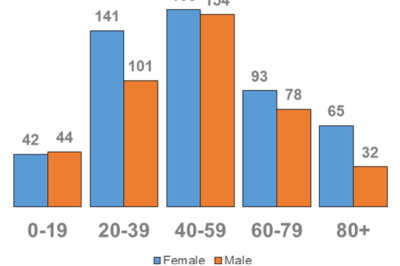 Infections by age and gender; This is no longer a virus that attacks just the elderly Figure 4 shows that by end of the day on July 29, the most COVID-19 cases were among Halton residents aged 40-59 (with 312 cases, or 34%). 499 cases (55%) were female. Two cases with unknown sex are excluded from the graph.
Females have outnumbered the males in terms of who got infected.
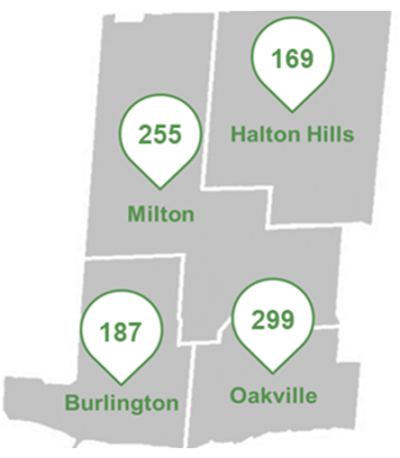 Figure 5 – infections by municipality. Figure 5 shows that by end of the day on July 29, the greatest number of COVID-19 cases were among residents of Oakville (with 299 cases, or 33%).
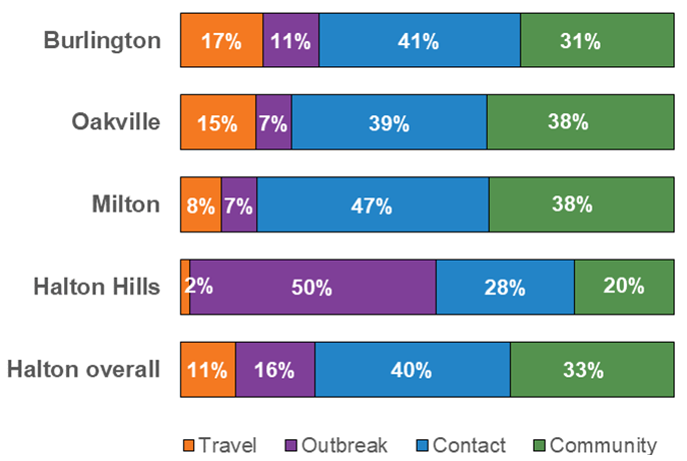 Figure 6: Where the public health people determined the infection came from. Figure 6 shows the percentage of COVID-19 cases by primary exposure category for Halton’s four municipalities and for Halton overall. For Halton overall, by end of day on July 29, 359 cases (40%) had contact with a confirmed case that was believed to be the source of their infection. 300 COVID-19 cases (33%) had no known travel or contact history, and therefore were believed to have acquired the virus within Ontario, making them community cases. 145 (16%) were residents/patients or staff associated with an outbreak in an institutional, congregate care, or workplace setting. 100 cases (11%) had a history of travel that was believed to have been the source of their infection. These proportions vary by municipality, and six cases with exposure information pending have been excluded.
It is important to note that cases can have multiple exposures, and these data reflect only their primary exposure category based on information gathered during case investigation.
Case and contact follow-up
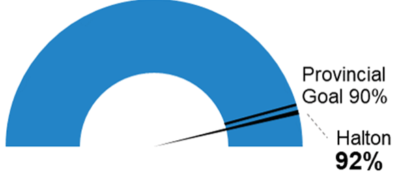 Figure 7 shows that 100% of Halton cases reported over the past seven days (Jul. 23-28) were reached by Halton Region Public Health within one day of being reported, which exceeds the provincial goal of 90%. Figure 8 shows that Halton Region Public Health reached 92% of contacts identified over the past seven days (Jul. 23-28) within one day, compared to the provincial goal of 90%. Figure 7 shows that 100% of Halton cases reported over the past seven days (Jul. 23-28) were reached by Halton Region Public Health within one day of being reported, which exceeds the provincial goal of 90%. Figure 8 shows that Halton Region Public Health reached 92% of contacts identified over the past seven days (Jul. 23-28) within one day, compared to the provincial goal of 90%.
It is important to note that Public Health attempted to reach 100% of cases and community contacts within one day but in some cases could not reach the client within that time span. Common reasons for not reaching clients within one day include incorrect phone number provided or client did not respond to repeated contact attempts.
Case outcomes
99 cases have ever been hospitalized to date – four are listed as currently in hospital.
861 cases have been resolved; 25 people have died to date (12 of the deceased were residents or patients of an institution experiencing an outbreak)
Institutional outbreaks
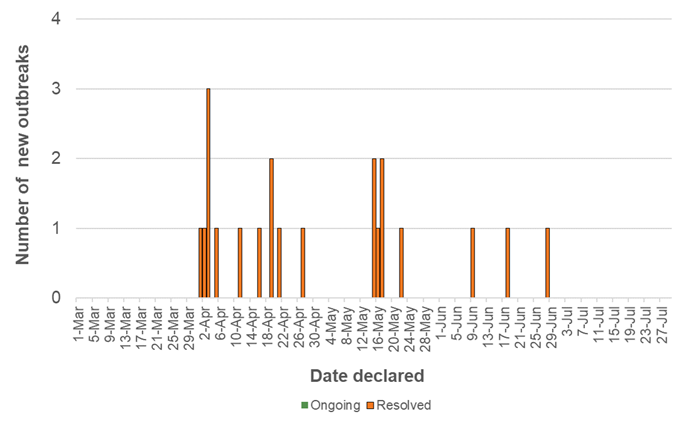 Figure 9 shows the 21 confirmed outbreaks of COVID-19 in Halton institutions reported by end of the day on July 29. Institutions are defined as long-term care homes, retirement homes and hospitals. All 21 of the outbreaks have resolved. Among the 21 confirmed institutional outbreaks reported to date, 13 (62%) have been in long-term care homes, seven (33%) have been in retirement homes and one (5%) has been in a hospital. Figure 9 shows the 21 confirmed outbreaks of COVID-19 in Halton institutions reported by end of the day on July 29. Institutions are defined as long-term care homes, retirement homes and hospitals. All 21 of the outbreaks have resolved. Among the 21 confirmed institutional outbreaks reported to date, 13 (62%) have been in long-term care homes, seven (33%) have been in retirement homes and one (5%) has been in a hospital.
Lab testing
>4,380
Halton residents were tested for COVID-19 within the past seven days of available data (Jul. 19-25)
>53,120
Halton residents are known to have been tested for COVID-19 to date
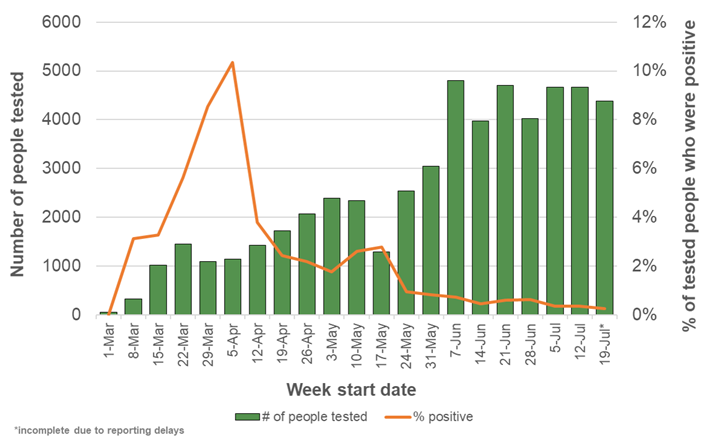 Figure 10″ The number of people tested and the percentage that were found to be positive. The green bars in Figure 10 show the number of Halton residents who were tested for COVID-19 each week, beginning the week of March 1-7. Data for the most recent week (Jul. 19-25) is incomplete due to reporting lags. The number of people tested decreased the week of May 17 compared to past weeks as mass testing of institutional residents was completed. The number of people tested then began to increase again, as the provincial government permitted more widespread testing.
The orange line in Figure 10 indicates the percentage of tested Halton residents who were positive for COVID-19. The percent positivity was highest the week of April 5-11, when 10.3% of Halton residents who were tested for COVID-19 had positive results. In the most recent week (Jul. 19-25), 0.3% of people tested for COVID-19 tested positive, although this number is subject to reporting delays.
Data limitations and Data sources
Halton case data: Case and Contact Management system (CCM), extracted at 7:00 AM on July 30, 2020, to reflect data entered by the end of the day on July 29, 2020
Halton lab testing data: Institute for Clinical Evaluative Sciences, Number of individuals who were confirmed positive for COVID-19, COVID-19 Testing Period: 15 Jan 2020 to 25 July 2020. Received on July 28, 2020.
Ontario case counts: Public Health Ontario, Epidemiologic Summary, COVID-19 in Ontario: January 15, 2020 to July 29, 2020, posted on July 30, 2020 to https://www.ontario.ca/page/2019-novel-coronavirus.
Denominators for Halton and Ontario age-specific rates: Population projections [2020], IntelliHEALTH Ontario, extracted on April 8, 2020.
Data notes
CCM is a dynamic disease reporting system which allows ongoing updates to data previously entered. As a result, data extracted from CCM represent a snapshot at the time of extraction and may differ from previous or subsequent reports. The data only represent cases reported to public health and recorded in CCM. As a result, all counts will be subject to varying degrees of underreporting due to a variety of factors, such as disease awareness and medical care seeking behaviours, which may depend on severity of illness, clinical practice, changes in laboratory testing, and reporting behaviours.
Figures 1 and 2 distinguish between lab-confirmed and probable cases. Probable cases are individuals presumed to have COVID-19 because they have symptoms of COVID-19 and are travelers returning from an affected area, have had close contact with a confirmed case, lived/worked in a facility experiencing a COVID-19 outbreak, or had indeterminate test results.All other figures and numbers include both confirmed and probable cases combined, except Figure 3, which uses confirmed cases only.
All data includes only individuals whose main usual residence is in Halton Region. Cases who have municipality information pending are excluded.
Active cases, resolved cases and deaths are a subset of total cases.
• Cases are considered to be active if the case is open in CCM and not listed as resolved.
• Case outcomes (resolved, deaths) reflect the latest available information reported to Halton Region Public Health and recorded in CCM by the extraction time.
• Resolved cases are persons who have been discharged from isolation at 14 days after symptom onset if they did not have a fever and their symptoms were improving for at least 72 hours OR 14 days from when they were tested if they were asymptomatic. For cases with no significant improvement in symptoms, Public Health continues monitoring until the case meets resolution criteria and the case is closed in CCM. For cases in hospital, a test-based approach may be used and isolation is continued until 2 consecutive negative tests are obtained, at least 24 hours apart.
• Deaths include any death that occurred among a person who tested positive for COVID-19, even if the death may not have been directly attributable to COVID-19.
In subsequent reports, counts in Figures 1-3 may increase as cases are added from past dates as individuals become symptomatic, get tested, and their results are reported to Halton Region Public Health, as well as any past results are added due to delayed data entry or new arrival of lab results.
Cases are considered to be patients or residents of an institution experiencing an outbreak if they are linked to a confirmed Halton institutional outbreak in CCM, and they are not known to be a staff person at the institution.
Cases are considered to work in health care if they are known to have an occupation that involves caring for patients, e.g. physician, nurse, occupational therapist, recreational therapist, chiropractor, paramedic, midwife, orderly, etc. Individuals who work in health care settings but do not provide direct care to patients (e.g. managers, cleaning staff) have not been included.
Exposure type is determined by examining the risk factor fields in CCM to determine whether a case travelled, was a resident/patient or staff member in an institution/congregate care setting/workplace experiencing an outbreak inside or outside Halton, was a contact of a case or neither. A hierarchy has been applied as follows:
• Cases with episode date before April 1: Travel > Associated with any type of outbreak (institutional, congregate care, or workplace) in or outside of Halton > Close contact of a confirmed case > None of the above (indicating community acquisition) > Information pending.
• Cases with episode date on or after April 1: Associated with any type of outbreak (institutional, congregate care, or workplace) in or outside of Halton > Close contact of a confirmed case > Travel > None of the above (indicating community acquisition) > Information pending.
It is important to note that cases can have multiple exposures, and these data reflect only their primary exposure category.
Differences between municipalities have not been assessed for statistical significance. Known cases reflect only individuals who were prioritized for testing prior to the expansion of testing in May, which means that differences between municipalities are currently difficult to ascribe to other factors.
Cases are considered to have been reached within 24 hours if their investigation start date and case reported dates in CCM are no more than one day apart.
Contacts are considered to have been reached within 24 hours if their interview completion date and reported dates in CCM are no more than one day apart.
Our main priority in outbreak management is prevention. Ensuring appropriate measures are being taken by the institutions requires time, in addition to collecting information on the status of the residents. Institutional outbreaks include outbreaks of COVID-19 in settings such as long-term care homes, retirement homes, hospitals and prisons. Outbreaks in congregate care settings (e.g. group homes) and workplaces are not included. Date declared for outbreaks reflects the outbreak classification date in CCM.
Lab testing data reflects only lab tests that have been assigned to Halton Region based on the methodology used by the Institute for Clinical Evaluative Sciences. There are several known limitations associated with this data:
• The unit of analysis is the testing episode (unique individuals tested per day). Individuals tested multiple times on different days are counted once in each week’s counts for the appropriate weeks. Testing episodes after the individual’s first confirmed positive COVID-19 test were excluded from subsequent weekly counts (numerator and denominator).
• The COVID-19 test results were captured in the Ontario Laboratories Information System (OLIS). The testing date represents the date of specimen collection: “observation date” in OLIS. Due to the time required for transportation and processing of specimens, it takes six days for approximately 95% of results to be finalized and reported for a given testing date. Some laboratories did not report all or part of their COVID-19 test results to OLIS. Unconsented test results were excluded;
• Counts less than six are suppressed;
• The location of tested individuals was based upon the test recipient’s postal code (and corresponding health unit) recorded in the OHIP Registered Persons Database (RPDB) for those residing outside a long-term care (LTC) facility, and the LTC address on the OLIS test requisition for specimens collected from LTC facilities. These address assignments lead to misclassification of PHU in approximately 14% of individuals
Data later
New Interactive Halton COVID-19 Dashboard:
Halton’s new interactive COVID-19 dashboard provides a summary of the current local situation and incorporates core epidemiological indicators of COVID-19 activity in Halton to date. Dashboard users can explore Halton’s COVID-19 data on overall case counts, case demographics, institutional outbreaks and lab testing. The dashboard can be accessed at halton.ca/covid19.
Also, please note that as of July 17, Halton Region Public Health is currently in the process of adopting a new provincial COVID-19 database. During this transitional period, all counts should be considered preliminary and are subject to change as information is reconciled.

 By Pepper Parr By Pepper Parr
July 31st, 2020
BURLINGTON, ON
The feeding of people in need is not small potatoes.
Food Banks have been with us for a long time and are going to be with us for much longer. The why of that being the case is another story.
The Burlington Food Bank has been around since the early 90’s. It is run now by Robin Bailey who has done a yeoman’s job of adapting to the constant change in the needs of the community.
 Robin Bailey, Executive Director of the Burlington Food Bank reports regularly to the community on what they have been able to do and where they need help. A lot of people lost their jobs when everything was locked down last March. There weren’t any jobs available anywhere and the fall back money just couldn’t cover as much as five months.
People who were self-isolated needed help in getting food – the Food Bank was there to deliver it to their door.
Burlington’s Food Bank has a very strong reputation both provincially and federally. They are part of the Feed Ontario set up that is used to funnel food to the local Food Banks
Bailey reports that his organization “just received the annual survey request from Feed Ontario asking us for our self reporting of policies and procedures.
Feed Ontario is truly supportive of the Burlington Food Bank in many ways such as sharing tips on best practices and to check on our regulations compliance with pest control and cleanliness or checking to make sure we’re giving food that meets criteria for expiry.
 These are just some of the people who sort the food that comes in and pack the food that goes out “We want to make sure we comply with all the standards for any Feed Ontario agency, for the benefit and safety of our clients.
Food Banks Canada gives us opportunities to learn more through their online training system so that we can study best practices from across the country. We are the member of both organizations for the City of Burlington and want to continue to lead the way as a visionary Food Bank to continuously learn how to better help our families. We also use our membership in these organizations to continue assisting other community partners in serving our community!
We will be reporting next week on what the Burlington Food Bank has done during the first five months of the pandemic and learning what Bailey expects the job to be in the months and years ahead.
Top ten needs at this point are:
- Peanut Butter
- Canned Pasta Sauce
- Canned Tomatoes
- Juice (Boxes and Litres)
- Hot Cereal
- Canned Meat (Chicken, Ham, Turkey)
- Shampoo, Deodorant, Toothpaste and Toothbrushes
- Coffee and Tea
- Crackers
- Mac and Cheese
Bailey closes every report he makes with this statement:
If you are in need or know of someone who could use our help PLEASE have them email us at info@burlingtonfoodbank.ca or call 905-637-2273 to make arrangements to have food dropped at their door or they can now pick it up. If you live in Burlington, we are here to help.

 By Staff By Staff
July 31st, 2020
BURLINGTON, ON
The Ontario government is encouraging everyone to download the new COVID Alert app on their smart phone from the Apple and Google Play app stores.
This app, which is available beginning today, lets users know if they may have been exposed to the virus. It is free, easy and safe to use. The more people who download the app, the more effective it will be in stopping the spread of COVID-19.
Work on COVID Alert was initiated in Ontario by the Ontario Digital Service and volunteers at Shopify, and was the foundation of the work by the Government of Canada. The app was developed in consultation with the Privacy Commissioners of Canada and Ontario to ensure the highest level of privacy for everyone using it.
 If you have been near anyone with this guy – technology can let you know. “This important, made-in-Ontario COVID Alert app will be a critical part of our case and contact management strategy as more regions in Ontario enter Stage 3 today,” said Premier Doug Ford. “This innovative tool was developed by some of the best and brightest minds in our province, working in partnership with Ottawa. As businesses open their doors and schools prepare for September, we need to help stop the spread and keep others safe by downloading this COVID Alert app.”
The COVID Alert app uses Bluetooth technology to detect when users are near each other. If a user tests positive for COVID-19, they can choose to let other users know without sharing any personal information. Ontarians who receive an exposure alert can then get tested and take action to help keep themselves, their families, and their friends from spreading COVID-19 throughout the community. The app does not collect personal information or health data, and does not know or track the location, name, address, or contacts of any user.
“Built with a privacy-first approach, COVID Alert is a safe and easy-to-use tool that Ontarians can download to protect themselves, their loved ones and their community from COVID-19,” said Christine Elliott, Deputy Premier and Minister of Health. “This Ontario-made app keeps people informed about being potentially exposed to the virus and allows them to act quickly to stop the spread of the virus. It is a key tool in our case and contact management strategy. I encourage all Ontarians to download the app, as early detection of cases will be important as we continue to carefully reopen more of the province.”
COVID Alert is a key tool to strengthen Ontario’s comprehensive case and contact management strategy, Protecting Ontarians through Enhanced Case and Contact Management. The app supports the efforts of public health units, allowing the province to quickly test, trace and isolate cases of COVID-19 to stop the spread of the virus and prepare for any potential outbreaks ― without sharing any personal information.
“As Ontario safely and gradually re-opens, we continue to take a digital-first approach to delivering simpler, faster, better services to support Ontarians, including the COVID Alert app, which will leverage technology to protect the health and safety of the people of Ontario,” said Peter Bethlenfalvy, President of the Treasury Board. “By making it easier for Ontarians to protect themselves, their loved ones and their communities, we continue to deliver on our commitment to build a smarter government that works for you.”
If an app user receives a message from COVID Alert that they may have been exposed to the virus, they should follow the public health advice given on the app and get tested. To notify other people if an app user has tested positive for COVID-19, they can enter their one-time key from Ontario’s test results website (Ontario.ca/covidresults) into the app. A message will then be sent to other app users who have been within two metres of them for at least 15 minutes within the past 14 days, without sending any information that identifies the user, or the time and place of exposure.
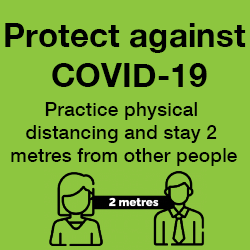 To stay safe as more of the province reopens, Ontarians should continue to follow public health guidelines including physical distancing with people not in their social circle, wearing a face covering if physical distancing is a challenge, washing hands thoroughly and frequently, and if anyone thinks they have COVID-19 or have been in contact with someone who has COVID-19, get tested. To stay safe as more of the province reopens, Ontarians should continue to follow public health guidelines including physical distancing with people not in their social circle, wearing a face covering if physical distancing is a challenge, washing hands thoroughly and frequently, and if anyone thinks they have COVID-19 or have been in contact with someone who has COVID-19, get tested.

 By Pepper Parr By Pepper Parr
July 31st, 2020
BURLINGTON, ON
Each of the city Councillors maintains a Newsletter which they send out to the constituents – if you’re not on the list – just ask and they will happily add your name,
Ward 4 Councillor Shawna Stolte finds that “City Hall has been an interesting flow of priorities. At first, all of the regular work of the City came to a halt as City Hall, libraries and community centres emptied and all of the focus was moved to the Emergency Response.
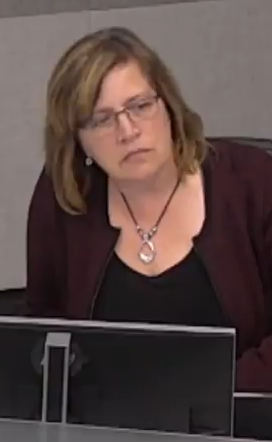 Councillor Stolte looking for a response to a motion she had put forward. Then, as spring turned into summer the work of the City slowly resumed and began to reopen, and now we are finally at the stage of getting the function of the City fully back up and running while we learn to live in co-existence with this pandemic.
The priority will still be to ensure that the citizens of this city are safe and that our business community can recover and thrive again while we also work hard towards moving this City into the future.
There are many projects on the go from
improving public transit
inspiring environmental initiatives
solidifying the Official Plan
crafting a Housing Strategy
an Affordable Housing Action Plan
introducing automated Speed Enforcement on our city streets
exploring Electoral Reform options
Several of these haven’t been heard of at either a Standing Committee meeting or Council meetings.
The public will want to know a lot more about Speed Enforcement as well as Electoral Reform.
Are these initiatives that Stolte is heading up? She was quite effective with her share the road that resulted in more space for pedestrians to walk around and she got the city to produce a bylaw making the wearing of face masks mandatory. On that face mask issue she had to arm wrestle the Mayor to maintain control of her initiative.
I think we are seeing more information on new issues from the ward Councillor than we are from the Mayor.

 By Staff By Staff
July 31st, 2020
BURLINGTON, ON
The biggest problem the governments are running into getting the economy running again is the need people have to gather in a bar somewhere, stand elbow to elbow (perhaps cheek to cheek) hoisting a cool one or clinking a wine glass – thereby negating the need to stay six feet apart and not breath in each other’s face.
That’s how the COVID19 virus gets around.
In an effort to reduce close contact between individuals in these settings, the province is implementing additional measures for restaurants, bars, and other food or drink establishments, as the province carefully and gradually reopens.
In order to keep patrons of restaurants, bars, and other food or drink establishments safe, the amended orders will implement the following measures:
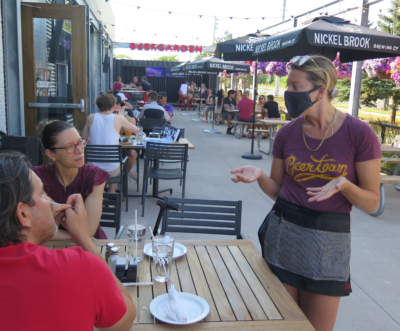 • All patrons will be required to be seated at all times, in both indoor and outdoor areas, with limited exceptions; and • All patrons will be required to be seated at all times, in both indoor and outdoor areas, with limited exceptions; and
• Bars and restaurants (and also tour boat operators) in Ontario will be required to keep client logs for a period of 30 days and to disclose the client logs to the medical officer of health or an inspector under the Health Protection and Promotion Act on request, which will support case and contact tracing.
• Complementary changes are being made in respect of existing provisions relating to tour operators and tour boat operators.
The Chief Medical Officer of Health and other public health experts continue to closely monitor the evolving situation to advise when public health measures or restrictions can be further loosened or if they need to be tightened.
Businesses and sectors unable to open or facing significant difficulties in operating under the current restrictions are invited to visit Ontario.ca/reopen to submit a reopening proposal. Businesses are also encouraged to use the government’s guide to develop a workplace safety plan.
Government officials will work collaboratively with them on a plan to safely reopen, where feasible. The plan will be considered by public health officials and the Ontario Jobs and Recovery Committee as part of Ontario’s approach to Stage 3.

 By Staff By Staff
July 31st, 2020
BURLINGTON, ON
The province announced earlier today that schools would open in September.
Elementary level students will remain a single cohort, five days per week, including for recess and lunch. Further, school boards will be required to provide the full curriculum. Class sizes will remain at the mandated maximum levels in place before the COVID-19 outbreak.
Secondary students in 24 “designated boards” — mainly in urban and suburban areas with relatively high student populations — will attend school on alternating days, in cohorts of about 15.
The Public is going to need some time to absorb this and determine what each household wants to do.
There are a lot of unanswered questions.
Busing students has some problems.
Here is what we do know:
- Students in grade 4-12 will be required to wear masks with exceptions for things like eating.
- Mask exemptions will be accommodated for those with valid reasons such as respiratory challenges.
- For students in JK-Grade 3, masks will be optional but encouraged.
- Schools will implement additional hand hygiene, cohorting, and distancing.
- Visitors in schools will be limited and will require pre-registration.
- Masks will be provided to teachers and staff.
- If a student or staff member is experiencing any symptoms of the COVID-19, they will be required to stay home.
- Physical distancing will be implemented as much as possible.
- Parents are allowed to decide whether their child returns to school in-person this September.
- Students will have the option of remote learning, which would be delivered by the school board.
- Any student or staff member who develop COVID-19 symptoms will be immediately separated from others. Staff and parents will then be contacted by their health provider and be informed about COVID-19 testing centres.
- School staff will receive training on processes and procedures.
- Organized sports and clubs can proceed if physical distancing can be maintained and equipment is cleaned regularly.

 By Pepper Parr By Pepper Parr
July 30th, 20020
BURLINGTON, ON
The Ontario Ministry of Education held a Technical Briefing this afternoon on the plans to re-open schools safely in September.
Shannon Fuller, Assistant Deputy Minister of Strategic Policy and Planning Division, Denys Giguere, Assistant Deputy Minister of French-Language Teaching, Learning and Achievement Division, Dr. David McKeown, Chair of Ontario’s Public Health Measures Table, and Nancy Naylor, Deputy Minister, from the Ministry of Education will be taking part.
A question and answer period followed the briefing. All information provided could not be attributed –it was for background purposes only.
Governments meet with media to outline approaches that are being taken to announcements they intend to make.
We can expect an announcement in the very near future on the re-opening of schools.
Governments tend to issue bad news on Friday afternoons of a long weekend.
We are going into a long weekend.
Tomorrow is a Friday.

 By Staff By Staff
July 30th, 2020
BURLINGTON, ON
The Halton District School Board has received notice from the Ministry of Education of final funding approval for a new secondary school in Oakville, a new elementary school in Milton and a child care centre renovation at Frontenac Public School in Burlington.
The renovation at Frontenac Public School in Burlington will create a two-room child care centre. Funding will also provide for regularly planned renewal work at the school to be completed.
Renovations to the child care centre at Frontenac Public School will begin immediately
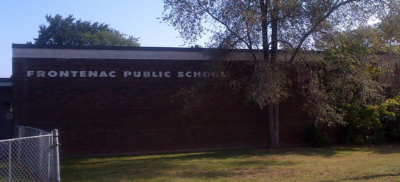 Frontenac Public School – Built in 1967. The provincial government will provide the following funding for these projects:
• $33,640,009 for the new Oakville secondary school (Oakville NE #1 hs)
• $19,183,165 for the new Milton elementary school (Milton SW #12 ps)
• $2,367,026 for the child care centre renovation and renewal work at Frontenac Public School
On behalf of HDSB students, the Board appreciates the role of the Ministry of Education and the Ontario government to improve the learning experience for students.
“We are grateful for the support of the Ontario government and the Ministry of Education for funding these three important projects. These new schools will help accommodate the tremendous housing growth occurring in Milton and Oakville,” says Stuart Miller, Director of Education for the Halton District School Board. “The renovation at Frontenac Public School will allow us to increase the number of child care spaces in our community and serve more families.”
Construction for the new schools in Oakville and Milton is expected to begin in Spring 2021.
The new secondary school in northeast Oakville (Oakville NE #1 hs), which will be located at Dundas St W and Neyagawa Blvd, will provide an innovative and supportive learning environment for 1,200 students.
Once complete, the new elementary school in southwest Milton (Milton SW #12 ps), which will be located on Kennedy Circle West, close to Louis St. Laurent Ave and Thompson Rd S, will accommodate 770 students and include five child care rooms.

 By Pepper Parr By Pepper Parr
July 29th, 2020
BURLINGTON, ON
Every household in the city that has children attending a school are faced with the questions:
When schools re-open will our children be in the classroom?
It is a very personal family decision – that is compounded by the realities of the modern family where Mom and Dad both work.
Once the parents are back at their desks – the kids have to be in school.
While the Premier of the province is doing his best to keep the public fully informed he is also being very cautious and quite loud when he learns of some of the really stupid social behaviour.
He wants students back in schools but he also wants to be certain that he gets it right the first time.
The public is wary of a government that wants things opened up for the sake of the economy – the parents want to be assured that there children will be safe.
The Hospital for Sick Children released a report today that represents the views of the medical community.
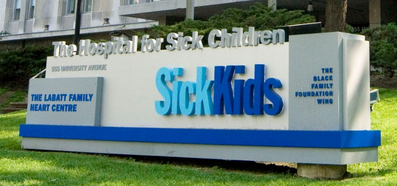 With a world class reputation – parents can take some comfort in their views on when students can return to school and what the conditions should be. SickKids has released new proposed guidelines for reopening schools in Ontario come September, including recommendations like staggered lunch times, no large assemblies, and mandatory masks for older students.
It suggests various health and safety protocols for schools that take a student’s age and developmental considerations into account.
The group says it is recommending the use of masks for high school students, with consideration for middle school students, whenever physical distancing can’t be maintained. Around 61 per cent of the authors agreed masks shouldn’t be required for elementary school kids.
“[Mask wearing] probably will diminish the infectivity of some individuals with COVID, however there are also a number of potential harms,” said Dr. Jeffrey Pernica of McMaster Children’s Hospital, saying that masks could distract and interfere with learning, especially for those with articulation problems, neurological issues, or kids who are learning a second language.
He also said that masks would have to be worn correctly in order to be effective, adding that it could be “impractical” for teachers to enforce.
The doctors aren’t recommending that elementary school children wear masks, saying that they could be a distraction and interfere with learning.
Most of the doctors also agreed that if community transmission is low, masking should not be mandatory for students returning to class.
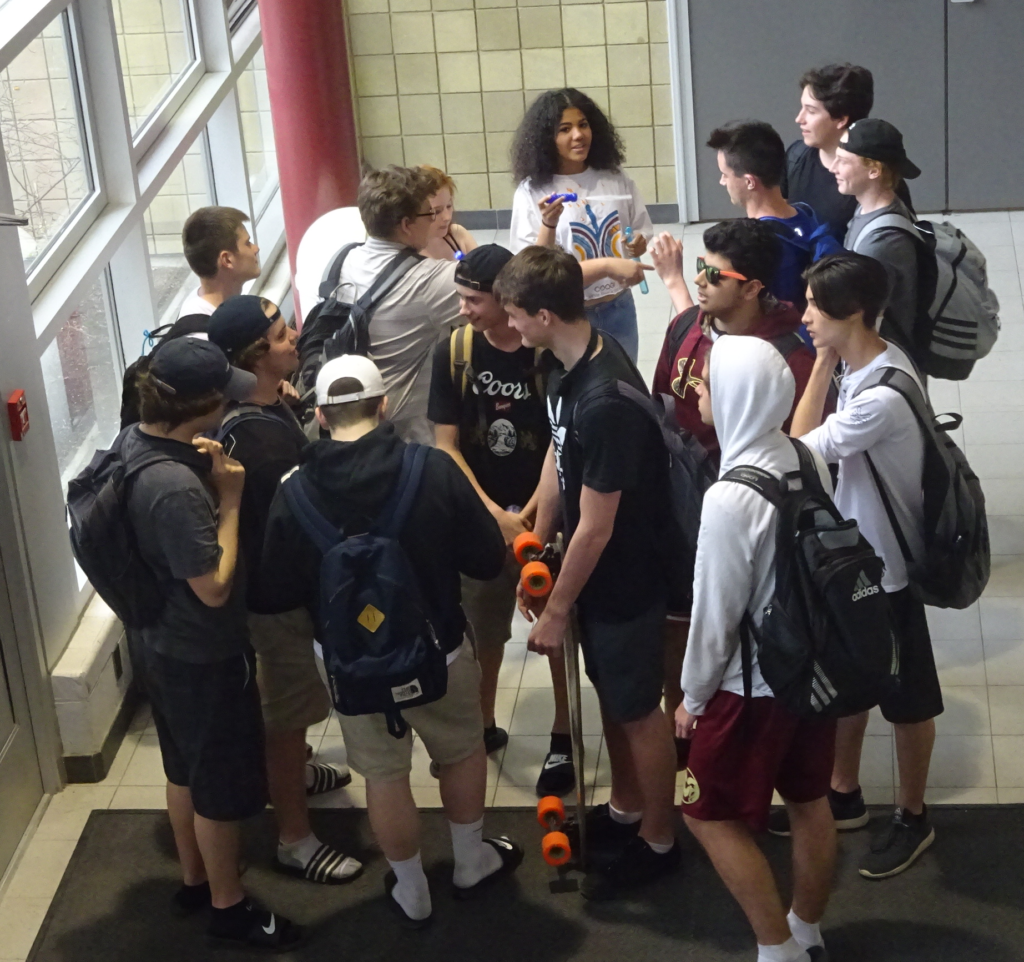 This is the number of students who will fill a classroom under COVIID19 conditions. Will they wear masks? “The lower the level of COVID in the community … the less benefit there is with masking — but the harms remain the same,” Pernica said. “This is why our recommendations are what they are right now.” Pernica also added that if the levels change, so will the recommendations.
Dr. Sean Ari Bitnun, a physician at SickKids, further emphasized that one single measure wasn’t going to mitigate things — success relies on the package.
“If we’re not focusing on any of the other recommendations, we are bound for disaster,” he said. “It really is the bundle effect that is going to create a safe environment for teachers and students.”
When it comes to physical distancing, the document says its role “should be discussed with students of all ages,” but added it would not be practical to enforce for kids in elementary school, especially during play times.
Instead, the report says “cohorting” — where kids would avoid mixing with other classes and grades — could be used as a strategy.
“Two metres is optimal, but the transmission at one metre is not significantly different,” said Dr. Charles Hui of CHEO.
Other recommendations include:
Implementing strict screening for students and employees who are symptomatic or have been exposed to the virus.
Teaching kids how to clean their hands properly with developmentally and age-appropriate material.
Arranging classroom furniture to leave space between students.
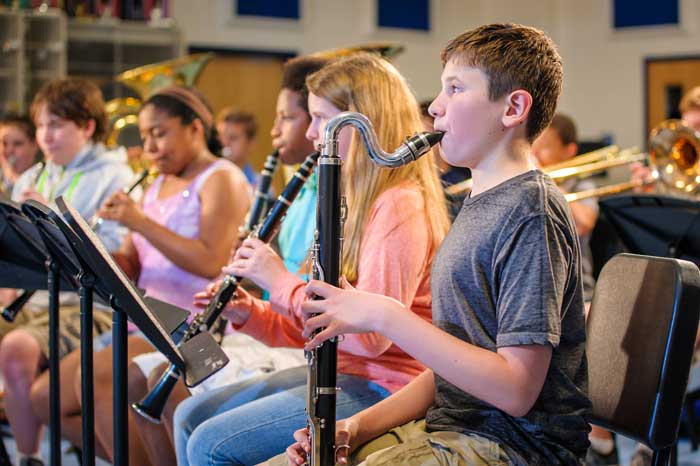 The wind instruments won’t get taken out of their cases this school year. Having smaller class sizes. Cancelling choir practices, performances, and band because of the high risk of transmission from wind instruments.
Continuing sports and physical education classes, but cleaning sports equipment and delaying team and close contact sports.
Implementing a regular cleaning schedule.
The doctors said that it would be up to each school to figure out how to implement changes when it came to aspects like running school libraries or preventing masses of students from rushing out into the hallways at the end of the school day.
Dr. Bitnun also called for local public health units to closely collaborate with schools, saying that “there will undoubtedly be positive cases with the children and for teachers.”
‘Putting out fires as they come up’
The document stresses that opening schools safely — and keeping them open — will be directly impacted by how the virus is spreading in the community.
The recommendations reflect a mark of less than 200 new confirmed cases a day, and experts say that “may evolve” as the epidemiology of COVID-19 changes and new evidence emerges.
The doctors said they haven’t identified a specific level of community spread that, if breached, would means schools would have to close.
“A specific number in isolation doesn’t really have value,” said Dr. Bitnun. “My view, and I think this is shared by the others, is maybe the most important thing is to have a robust system of testing and contact tracing … in other words, we should focus on, to paraphrase, putting out fires as they come up rather than shutting down everything based on a specific number.”
Staying home could impact already vulnerable students
The experts quoted in the document continue to push for full-time instruction, saying that remote learning would be “insufficient to meet the needs” of youth.
“Thinking about developmental impact and mental health impact has to be in the same equation as the potential harm of COVID,” said Dr. Sloan Freeman, lead pediatrician at St. Michael’s Hospital.
There are risks to Ontario schools reopening full-time but ways to mitigate them, experts say
Going back to part time, they said, would affect working parents and caregivers, and mean bringing more people into the loop, like babysitters or grandparents.
Not going back, doctors say, could impact already vulnerable students the most.
 Difficult children will find it hardest to cope with the changes. “Medically complex children or children with severe underlying medical or behavioural illness, I think those families are disproportionately affected by what is going on in terms of isolation and trying to manage at home,” said Dr. Jeremy Friedman, a pediatrician at SickKids. “I think that those families, more than any others probably, will not be able to withstand the sort of time period we’re talking about for [when] this pandemic has moved into a more stable phase.”
“The sad irony is that I think that the children who are perhaps the most fragile and most at risk, those children, those families are the ones that probably need to have the normality and the routine,” he said.

 By Staff By Staff
July 29th, 2020
BURLINGTON, ON
How do you work a business plan during a pandemic?
The fleet of foot are in a constant pivoting position.
The conditions change daily – and the rules have to be revised to recognize and deal with the new reality.
On August 7th there will be a Webinar that pulls together key people directly involved in changing the rules and regualtions when a change is necessary.
During this webinar, businesses will have the opportunity to connect directly with senior City of Burlington staff to understand how the City and its counterparts at Burlington Economic Development are adapting to support businesses during COVID-19 as well as help plan for long-term economic recovery.
The City of Burlington Customer Experience is being re imagined in light of new physical distancing requirements and other COVID-19 adaptations in the workplace. This includes:
• Investing in an online appointment booking application to reduce wait times
• The ability to submit development applications electronically
• Rolling out an “Open for Business” customer service window for easy public access and on-the-spot collaboration and problem-solving
• Adapting to support retail and restaurants to allow the expansion of restaurant space and use of downtown parking for curbside pick-up
Other opportunities for discussion will include Burlington’s mandatory mask by-law, and the launch of the Burlington Economic Recovery Network, a Team Burlington initiative.
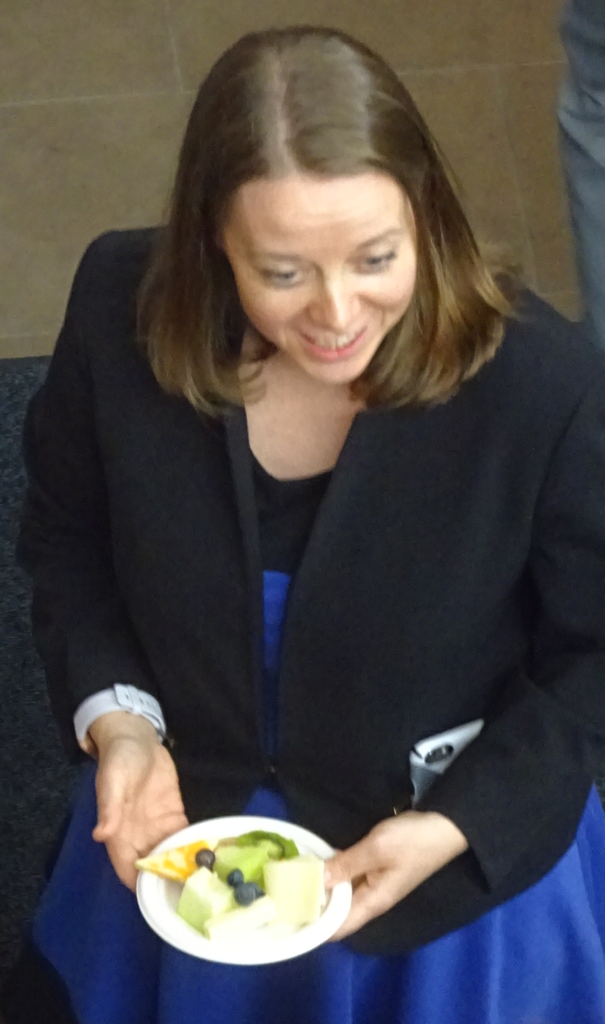 Anita Cassidy, Executive Director of Burlington Economic Development REGISTER HERE
Moderator
• Anita Cassidy – Executive Director of Burlington Economic Development
Panelists
• Heather MacDonald – Executive Director of Community Planning, Regulation and Mobility
• Jamie Tellier – Acting Director of Community Planning
• Nick Anastasopoulos – Director of Building and By-law, Chief Building Official
• Brynn Nheiley – Manager of Development Planning
• Jenna Puletto – Special Business Area Coordinator, Senior Planner – Official Plan
• Kerry Davren – Manager of Bylaw

 By Pepper Parr By Pepper Parr
July 29th, 2020
BURLINGTON, ON
The Mayor reports that: “At a special meeting July 28, Burlington City Council approved amendments to our temporary Mask By-law which regulates the use of face masks and coverings within enclosed spaces open to the public.
“The amendments were made for consistency with Halton Region’s Mask Bylaw and on advice received from Halton Region’s Medical Officer of Health.
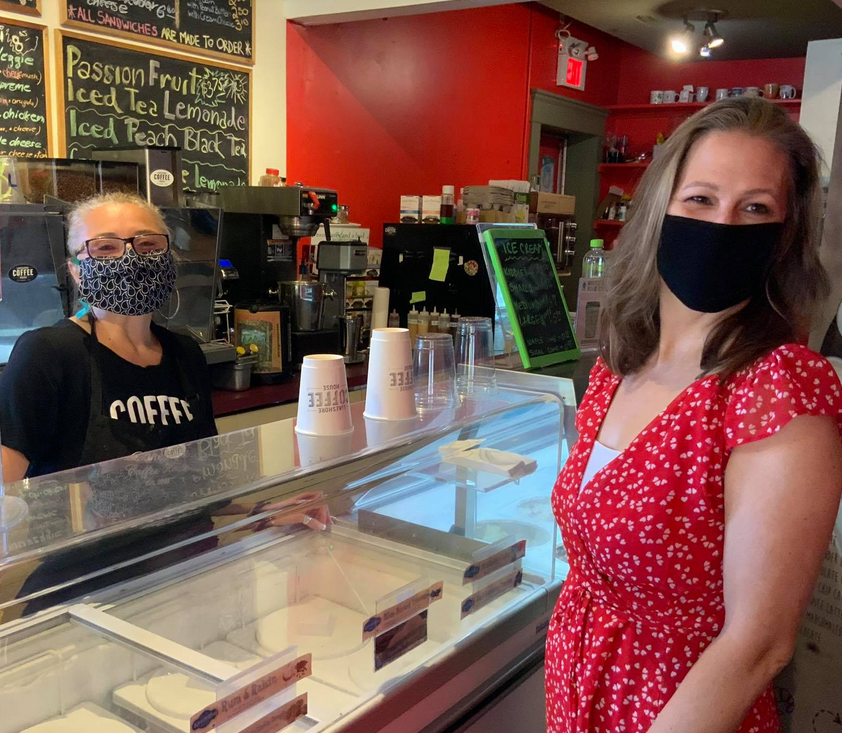 Mayor Meed Ward out and about sporting a fashionably black face mask Missing is a city crest. “The By-law was implemented in an effort to reduce the spread of COVID-19 and protect the health and safety of the community.
“The changes are now in effect and include:
* Exempting children under the age of five from wearing a mask (previously children under three).
* Requiring parents/guardians of children over five years of age to make a “best effort” to ensure the children wear a mask
* Removing face shields as an acceptable face covering. Public Health information indicates that face coverings need to cover the nose and mouth without gapping
* Updating wording related to “employee-only areas” which are not regulated under the by-law
Applying the Mask By-law to City recreation facilities.
”The updates to our temporary mask by-law will help ensure residents have consistency in the Burlington and Halton Region bylaws”, said the Mayor who added: “Masks are an essential way to help mitigate the spread of COVID-19 so we can continue to move forward in reopening businesses and schools and getting back to more of the activities we all enjoy. I encourage all our residents to wear a mask in public indoor spaces to help protect our families, friends, and community.
“The removal of face shields as an alternative to face masks was based on advice from Halton Region’s Medical Officer of Health during discussion at Halton Regional Council of the Region’s mask bylaw. Face shields can be an added layer of protection when worn with a face masks, but based on medical advice are not considered a substitute for a face mask.”
Not everyone agrees with the Mayor. Hopefully the comment from Bruce Lacillade is that of a very small minority. “Again, Marianne, I am disappointed in you. Forcing citizens to give up their humanity and be treated as nothing more than a disease! Masking is only another step toward total control of society; you know that. The coronavirus is an influenza virus nothing more.

 By Pepper Parr By Pepper Parr
July 29, 2020
BURLINGTON, ON
Aug 10th, when we know what direction the Ministry has given us
How many people are missing those Back to School Sales flyers that would normally be stuffed inside whatever gets dropped off at your house?
Most parents are wondering just when (some ask if) school is going to start. September 7th is the scheduled resumption of classes but at this point no one at any of the school boards knows what the province is going to dictate.
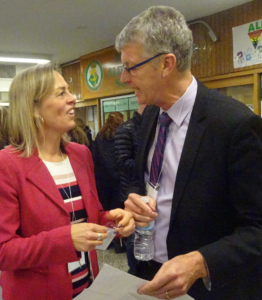 HDSB Superintendent Terri Blackwell speaking with Director of Education Stuart Miller School boards from across the province have been meeting with Ministry of Education officials setting out how they would teach under one of the three scenarios the province outlines:
All teaching done remotely
All teaching done in schools with classes limited to 15 students
An Alternative approach that was a combination of the other two scenarios.
The Halton District School Board (HDSB) has prepared a very detailed schema for the elementary and secondary students. They have not released the details because they don’t yet know what the province is going to direct them to deliver.
HDSB Director of Education Stuart Miller didn’t want to confuse parents by sending out information that may prove not to be applicable.
What the School Board will be doing is sending a questionnaire to parents asking if they plan to send their children back to school when the province clears the way. Miller and his staff want to know if the parents will send their children to a school or if they want them to be taught remotely.
We know now that there will not be gym classes, French classes will be limited and that there will not be any extra-curricular or co-curricular activities.
The bigger question for many is: How long will school have to operate under these restrictions? All of the 20-21 academic year?
An announcement of some sort was expected by the ends of this week – the Gazette has since learned that an announcement will be made on August 10th.

 By Pepper Parr By Pepper Parr
July 29th, 2020
BURLINGTON, ON
The city administration has been hoping to see some light at the end of the tunnel – the hits on the revenue side for the city during the State of Emergency were hurting.
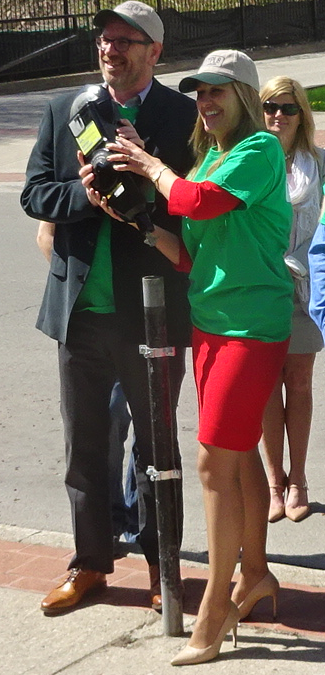 Marianne Meed Ward, before she was elected Mayor holding one of the last coin operated parking meters in the downtown core. Brian Dean – chief cheese for the business people locally lends a helping hand. The Mayor had the city “$18 million in the hole”, which wasn’t true. It was more like $4 million with the Finance department looking for ways to lighten the financial burden of the pandemic on the citizens of the city.
They announced earlier today that the free parking in the downtown core comes to an end of August 4th. They put it this way: “…payment will be required in the downtown for on-street parking and in municipal parking lots starting Tuesday, Aug. 4, 2020.”
Recent observations, review of occupancy data and feedback from the public indicate that parking is steadily increasing to pre-COVID levels. It is anticipated the increase in parking demand will continue as most businesses reopen since Halton Region entered Stage 3 on July 24, 2020.
Visitors using downtown parking are encouraged to use the HONK Mobile app. Honk offers touch-free payment and reduces the number of people touching the same parking machines throughout the day.
Mayor Marianne Meed Ward said: “As our community begins to enjoy more activities with Stage 3 reopening, we’ve seen an increase in parking demand and desire to manage supply and revenues. Council listened to the voices of the business community and Downtown Parking Committee to reinstate paid parking. Discussions are also underway about returning some of the 20-minute curbside pickup to regular paid parking.”

|
|
 By Michele Bogle
By Michele Bogle

















 Haven’t heard of geometric progression? The explanation for the pattern of American infections lies in something of central importance to the spread of a virus: geometric progression, such as 1, 2, 4, 8, 16.
Haven’t heard of geometric progression? The explanation for the pattern of American infections lies in something of central importance to the spread of a virus: geometric progression, such as 1, 2, 4, 8, 16.

















 Figure 7 shows that 100% of Halton cases reported over the past seven days (Jul. 23-28) were reached by Halton Region Public Health within one day of being reported, which exceeds the provincial goal of 90%. Figure 8 shows that Halton Region Public Health reached 92% of contacts identified over the past seven days (Jul. 23-28) within one day, compared to the provincial goal of 90%.
Figure 7 shows that 100% of Halton cases reported over the past seven days (Jul. 23-28) were reached by Halton Region Public Health within one day of being reported, which exceeds the provincial goal of 90%. Figure 8 shows that Halton Region Public Health reached 92% of contacts identified over the past seven days (Jul. 23-28) within one day, compared to the provincial goal of 90%. Figure 9 shows the 21 confirmed outbreaks of COVID-19 in Halton institutions reported by end of the day on July 29. Institutions are defined as long-term care homes, retirement homes and hospitals. All 21 of the outbreaks have resolved. Among the 21 confirmed institutional outbreaks reported to date, 13 (62%) have been in long-term care homes, seven (33%) have been in retirement homes and one (5%) has been in a hospital.
Figure 9 shows the 21 confirmed outbreaks of COVID-19 in Halton institutions reported by end of the day on July 29. Institutions are defined as long-term care homes, retirement homes and hospitals. All 21 of the outbreaks have resolved. Among the 21 confirmed institutional outbreaks reported to date, 13 (62%) have been in long-term care homes, seven (33%) have been in retirement homes and one (5%) has been in a hospital.



 To stay safe as more of the province reopens, Ontarians should continue to follow public health guidelines including physical distancing with people not in their social circle, wearing a face covering if physical distancing is a challenge, washing hands thoroughly and frequently, and if anyone thinks they have COVID-19 or have been in contact with someone who has COVID-19, get tested.
To stay safe as more of the province reopens, Ontarians should continue to follow public health guidelines including physical distancing with people not in their social circle, wearing a face covering if physical distancing is a challenge, washing hands thoroughly and frequently, and if anyone thinks they have COVID-19 or have been in contact with someone who has COVID-19, get tested.
 • All patrons will be required to be seated at all times, in both indoor and outdoor areas, with limited exceptions; and
• All patrons will be required to be seated at all times, in both indoor and outdoor areas, with limited exceptions; and













